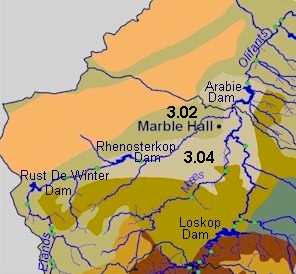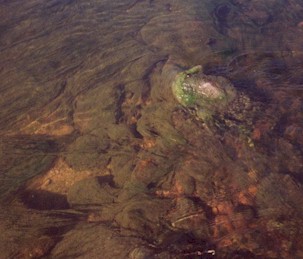|
The Olifants River System
Ecoregion 3.02 & 3.04
|
|
Ecoregion and River Characteristics
This is an area of middle slopes (800-1 500 m) with mixed bushveld overlying shallow coarse sandy soils on mudstone, sandstone and shale. Average annual precipitation is 400-800 mm and temperatures range from 16-22°C.
The Rust de Winter Dam is situated in the Elands River, which rises east of Bronkhorstspruit. The Olifants River meanders from the Loskop Dam through relative flat landscape past Groblersdal and Marble Hall to the Arabie Dam, at the confluence of the Elands and Olifants Rivers. The riverbed is sandy due to alluvial deposits. From the Arabie Dam, the Olifants River flows through the Springbok Flats, which forms part of the Bushveld Basin.
The river is steep with many riffles in ecoregion 3.02, becoming gentler with a sandy soft bed in ecoregion 3.04.
|
|

|
Present Ecological State
River habitats in this region are in a
poor
to
unacceptable
state. The exception is upstream of the Rust de Winter Dam where the Elands River is in a
fair
condition. In-stream biota in the Olifants River is fair
to
poor
, with the riparian vegetation being in a
poor
state. For the Elands River the riparian vegetation is fair
, but in-stream biota varies from
fair
to
unacceptable
. The worst part is immediately downstream of Rust De Winter Dam, where the river is often dry because releases from the dam are insufficient or non-existent.
|
|
|
Drivers of Ecological Change (Land-use activities)
Ecoregion 3.02
The riparian zone is in a degraded state due to deforestation within the riparian zone for small scale and subsistence agricultural activities or firewood collection. Cattle and goats graze in the riparian zone. Alien vegetation, including seringa (Melia azedarach), is abundant.
On the Elands River, downstream of the Rust de Winter Dam, river flow is extremely regulated with very infrequent releases. The regulation of flow has a severe impact on in-stream biota but does not seem to affect riparian vegetation, probably due to groundwater availability. Eucalypts grow very aggressively and infestations occur.
On the Olifants River the riparian vegetation is overgrazed and over utilised. As a result, riverbanks are collapsing due to erosion, and sedimentation occurs in the riverbed.
|
|
Ecoregion 3.04
The Olifants River, upstream of the Arabie Dam, is impacted by agricultural activities. Runoff from commercial agricultural areas contains agro-chemicals, which cause eutrophication or contamination of water, either of which can impair the health of invertebrates and fish. Increased erosion and sedimentation is also a problem. The primary impact in the Elands River is ecologically insensitive releases of water from the Rhenosterkop Dam, for example no flow on one day followed by flooding the next. These artificial flow regimes change the riverbed, causes erosion and results in undesirable habitat conditions for in-stream biological communities.
|

|
|
|
Desired Ecological State and Response by Resource Managers
The desired ecological state for this region is
fair
. Eucalypts (Eucalyptus spp.) Sesbania (Sesbania punicea) and Seringa (Melia azedarach), have the ability to spread aggressively, especially along streams and riverbanks, and should be contained and eradicated where possible. Water release management from Rust de Winter, Rhenosterkop and Arabie Dams must be improved. On the Olifants River the lowland floodplain is ecologically significant as it serves as a refuge area for fish. For this reason the area around the floodplain must be maintained in a
good
condition.
The determination of an ecological reserve and associated in-stream flow requirements will provide the basis for future improvements.
|





|























